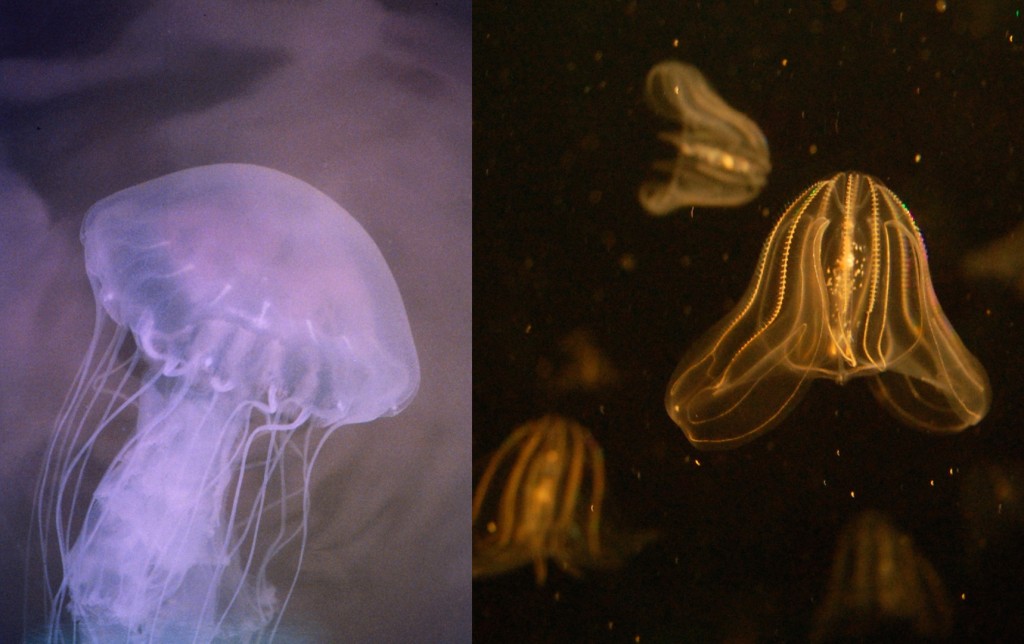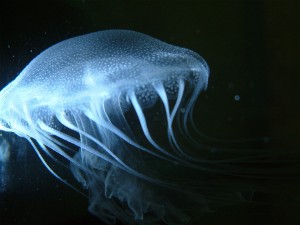Every summer, the food web in Chesapeake Bay gets jostled around as two plankton-eating predators jockey for power: comb jellies and jellyfish. Most smaller species don’t have a stake in the battle—both predators eat zooplankton and fish eggs, after all. But for young oyster larvae, the victor could make the difference between being protected civilians or collateral damage.
“Comb jellies” is the common name for a group of animals called ctenophores. Comb jellies have the same translucent bodies as jellyfish, but lack the stinging tentacles and swim by beating rows of hair-like cilia. They’re also thought to be part of the oldest branch on the animal family tree. And they don’t die easily. In the absence of predators like jellyfish, comb jellies are remarkably resistant to starvation.
“When food’s in short supply, they can just shrink,” says Denise Breitburg, a marine ecologist at the Smithsonian Environmental Research Center who tracked the comb jelly-versus-jellyfish battle in a new study published in September. “So a shortage of food doesn’t automatically kill them.”
The problem lies in what the Bay’s most abundant comb jelly, Mnemiopsis leidyi, eats when it’s not starving: tiny zooplankton, bay anchovy eggs—and oyster larvae.
On the other side of the fray swims Chrysaora quinquecirrha, better known by the name “sea nettle,” the most common summer jellyfish in the Chesapeake. Because sea nettles eat comb jellies and leave oysters alone, which species gains the upper hand could mean life or death for an area’s new generation of oysters.

Left: Sea nettle Chrysaora quinquecirrha (NOAA). Right: Comb jelly Mnemiopsis leidyi (Steven G. Johnson). Comb jellies eat oyster larvae, but sea nettles eat the comb jellies.
Traditionally, comb jellies are most abundant in the center of large rivers and the mainstem Chesapeake Bay, while sea nettles seem to have their strongholds in smaller creeks and coves. But until recently, reports on the relative abundance of comb jellies and sea nettles in these different habitats were based largely on anecdotal evidence. In the new study, Breitburg and SERC technician Rebecca Burrell watched the annual clash to confirm the sea nettle’s territory. Breitburg and Burrell spent three summers observing the battle in the Patuxent River and the Patuxent’s upriver creeks.
At first, comb jellies had the upper hand. They emerged before the sea nettles in late May, in the mainstem of the Patuxent River. As their numbers bulged, they began to infiltrate the Patuxent’s inner creeks in mid-June. “A big advantage that the ctenophores have is that they have a very short life cycle and an incredibly high reproductive rate,” Breitburg said. A comb jelly can grow from an egg to a reproductive adult in just three weeks, and a large adult can produce up to 15,000 eggs a day. “Their numbers can just explode very quickly.”
But the comb jelly expansion was short-lived. The sea nettles began to bloom in the creeks in mid-June, and the arrival of comb jellies presented a free feast. The onslaught of predation by sea nettles wiped out most of the comb jellies by the middle of July, except in the mainstem river. Sea nettles eventually reached the mainstem of the Patuxent in August. But by September, both species began to dwindle until the next year, when the cycle would begin again.
There’s a reason comb jellies become abundant in the center of the river. The comb jellies have a large overwintering population in the mainstem of the Patuxent, which fuels their population boom in May. Less clear is why sea nettles occupy the inner creeks and coves. The shallow waters could offer the overwintering stage of sea nettles (called polyps) more hard surface to settle on, says Breitburg. In addition, stronger currents in the mainstem could push more sea nettles out of the main river.
But for oysters caught in the middle, the three-month fray has very real consequences. During June, at the peak of their expansion, comb jellies can remove 100 percent of an area’s bay anchovy eggs, zooplankton and (assuming the same clearance rates apply) oyster larvae. By July and August, when sea nettles begin feeding on the encroaching comb jellies in most years, that number shrinks to around 10 percent.
If sea nettles have that much power to protect oysters from predators, Breitburg says, areas where they thrive may be the some of the best candidates for new oyster reefs. Instead of focusing solely on the Bay, or even its larger tributaries, it may be time for more oyster restoration in the creeks and coves.
The study was published in the September 9 issue of Marine Ecology Progress series. To read the full text, click here.


